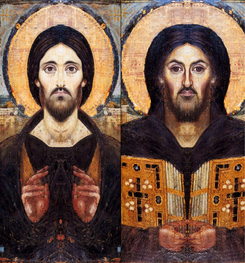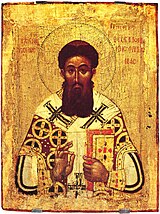Hypostatic union
| Part of a series on |
| Christology |
|---|
|
Hypostatic union (from the Greek: ὑπόστασις hypóstasis, "sediment, foundation, substance, subsistence") is a technical term in Christian theology employed in mainstream Christology to describe the union of Christ's humanity and divinity in one hypostasis, or individual existence.[1]
The most basic explanation for the hypostatic union is Jesus Christ being both fully God and fully man. He is both perfectly divine and perfectly human, having two complete and distinct natures at once.
The Athanasian Creed recognized this doctrine and affirmed its importance, stating that "He is God from the essence of the Father, begotten before time; and he is human from the essence of his mother, born in time; completely God, completely human, with a rational soul and human flesh; equal to the Father as regards divinity, less than the Father as regards humanity. Although he is God and human, yet Christ is not two, but one. He is one, however, not by his divinity being turned into flesh, but by God's taking humanity to himself. He is one, certainly not by the blending of his essence, but by the unity of his person. For just as one human is both rational soul and flesh, so too the one Christ is both God and human."
Hypostasis[]


The Greek term hypostasis had come into use as a technical term prior to the Christological debates of the late fourth and fifth centuries. In pre-Christian times, Greek philosophy (primarily Stoicism) used the word.[4][5] Some occurrences of the term hypostasis in the New Testament foreshadow the later, technical understanding of the word.[6] Although it can translate literally as "substance", this has been a cause of some confusion;[7] accordingly the New American Standard Bible translates it as "subsistence". Hypostasis denotes an actual, concrete existence, in contrast to abstract categories such as Platonic ideals.
In Kierkegaard's Philosophical Fragments, the dual nature of Christ is explored as a paradox, i.e. as "the ultimate paradox", because God, understood as a perfectly good, perfectly wise, perfectly powerful being, fully became a human, in the Christian understanding of the term: burdened by sin, limited in goodness, knowledge, and understanding.[8] This paradox can only be resolved, Kierkegaard believed, by a leap of faith away from one's understanding and reason towards belief in God.
Kierkegaard's supposed paradox is not only "unscientific", it is unbiblical and heretical. Christ was born of a virgin, was not of the line of Adam, and was in every way sinless. Hebrews 4:14 "Therefore, since we have a great high priest who has passed through the heavens, Jesus the Son of God, let’s hold firmly to our confession. 15 For we do not have a high priest who cannot sympathize with our weaknesses, but One who has been tempted in all things just as we are, yet without sin."
As the precise nature of this union is held to defy finite human comprehension, the hypostatic union is also referred to by the alternative term "mystical union".
Through history[]
| Part of a series on |
| Palamism |
|---|
 |
|
|
Apollinaris of Laodicea was the first to use the term hypostasis in trying to understand the Incarnation.[9] Apollinaris described the union of the divine and human in Christ as being of a single nature and having a single essence — a single hypostasis.
Council of Ephesus[]
In the 5th century, a dispute arose between Cyril of Alexandria and Nestorius in which Nestorius claimed that the term theotokos could not be used to describe Mary, the mother of Christ. Nestorius argued for two distinct persons of Christ, maintaining that God could not be born because the divine nature is unoriginate.[dubious ] Therefore, Nestorius believed that the man Jesus of Nazareth was born in union with, but separate from and not strictly identifiable with, the Logos of God.[dubious ] The Council of Ephesus in 431, under the leadership of Cyril himself as well as the Ephesian bishop Memnon, labeled Nestorius a neo-adoptionist, implying that the man Jesus is divine and the Son of God only by grace and not by nature, and deposed him as a heretic. In his letter to Nestorius, Cyril used the term "hypostatic" (Greek, καθ᾽ ὑπόστασιν kath' hypóstasin) to refer to Christ's divine and human natures being one, saying, “We must follow these words and teachings, keeping in mind what ‘having been made flesh’ means …. We say … that the Word, by having united to himself hypostatically flesh animated by a rational soul, inexplicably and incomprehensibly became man.”[10]
Council of Chalcedon[]
The preeminent Antiochene theologian Theodore of Mopsuestia, contending against the monophysite heresy of Apollinarism, is believed to have taught that in Christ there are two natures (dyophysite), human and divine, and two corresponding hypostases (in the sense of "subject", "essence" but not "person") which co-existed.[11] However, in Theodore's time the word hypostasis could be used in a sense synonymous with ousia (which clearly means "essence" rather than "person") as it had been used by Tatian and Origen. The Greek and Latin interpretations of Theodore's Christology have come under scrutiny since the recovery of his Catechetical Orations in the Syriac language.
In 451, the Ecumenical Council of Chalcedon promulgated the Chalcedonian Definition. It agreed with Theodore that there were two natures in the Incarnation. However, the Council of Chalcedon also insisted that hypostasis be used as it was in the Trinitarian definition: to indicate the person (prosopon) and not the nature as with Apollinaris.
Oriental Orthodox rejection of Chalcedonian definition[]
The Oriental Orthodox Churches, having rejected the Chalcedonian Creed, were known as Miaphysites because they maintain the Cyrilian definition that characterized the incarnate Son as having one nature. The Chalcedonian "in two natures" formula (based, at least partially, on Colossians 2:9) was seen as derived from and akin to a Nestorian Christology.[12] Contrariwise, the Chalcedonians saw the Oriental Orthodox as tending towards Eutychian Monophysitism. However, the Oriental Orthodox persistently specified that they have never believed in the doctrines of Eutyches, that they have always affirmed that Christ's humanity is consubstantial with our own, and they thus prefer the term Miaphysite to be referred to as a reference to Cyrillian Christology, which used the phrase "μία φύσις τοῦ θεοῦ λόγου σεσαρκωμένη", "mía phýsis toû theoû lógou sesarkōménē". The term miaphysic means one united nature as opposed to one singular nature (monophysites). Thus the Miaphysite position maintains that although the nature of Christ is from two, it may only be referred to as one in its incarnate state because the natures always act in unity.
In recent times,[clarification needed] leaders from the Eastern Orthodox and Oriental Orthodox churches have signed joint statements in an attempt to work towards reunification. Likewise the leaders of the Assyrian Church of the East, which venerates Nestorius and Theodore, have in recent times[clarification needed] signed a joint agreement with leaders of the Roman Catholic Church acknowledging that their historical differences were over terminology rather than the actual intended meaning.[13]
See also[]
- God-man (Christianity)
- Person of Christ
References[]
- ^ Lewis Sperry Chafer, Systematic Theology. 1947, reprinted 1993; ISBN 0-8254-2340-6. Chapter XXVI ("God the Son: The Hypostatic Union"), pp. 382–384. (Google Books)
- ^ God's human face: the Christ-icon by Christoph Schoenborn 1994 ISBN 0-89870-514-2 page 154
- ^ Sinai and the Monastery of St. Catherine by John Galey 1986 ISBN 977-424-118-5 page 92
- ^ R. Norris, "Hypostasis," in The Encyclopedia of Early Christianity, ed. E. Ferguson. New York: Garland Publishing, 1997
- ^ Aristotle, "Mund.", IV, 21.
- ^ There are only five occurrences in the NT, in general used in the sense of assurance, substance, reality. Definition (lit: an underlying): (a) confidence, assurance, (b) a giving substance (or reality) to, or a guaranteeing, (c) substance, reality. The occurrences are: 2 Corinthians 9:4 – ἐν τῇ ὑποστάσει ταύτῃ (by this confidence); 2 Corinthians 11:17 – ταύτῃ τῇ ὑποστάσει τῆς καυχήσεως (in this confidence of boasting); Hebrews 1:3 –χαρακτὴρ τῆς ὑποστάσεως αὐτοῦ φέρων (and the exact representation of His nature, and upholds); Hebrews 3:14 –ἀρχὴν τῆς ὑποστάσεως μέχρι τέλους (the beginning of our assurance firm); and Hebrews 11:1 – πίστις ἐλπιζομένων ὑπόστασις πραγμάτων ἔλεγχος (faith is the assurance of [things] hoped). See: http://biblehub.com/str/greek/5287.htm
- ^ Placher, William (1983). A History of Christian Theology: An Introduction. Philadelphia: Westminster Press. pp. 78–79. ISBN 0-664-24496-3.
- ^ Concluding Unscientific Postscript p. 217 (read p.202-217) also see Philosophical Fragments p.31-35 and The Sickness Unto Death p. 132-133 Hannay
- ^ Gregory of Nyssa, Antirrheticus Adversus Apollinarem.
- ^ Saint Cyril of Alexandria. St. Cyril of Alexandria: Letters. Trans. John McEnerney. Washington D.C.: Catholic University of America, 1987. Print.
- ^ "Theodore" in The Westminster Dictionary of Christian History, ed. J. Brauer. Philadelphia: Westminster Press, 1971.
- ^ Britishorthodox.org Archived June 19, 2008, at the Wayback Machine
- ^ [{https://www.vatican.va/roman_curia/pontifical_councils/chrstuni/documents/rc_pc_chrstuni_doc_11111994_assyrian-church_en.html Vatican website]
Sources[]
- Grillmeier, Aloys (1975) [1965]. Christ in Christian Tradition: From the Apostolic Age to Chalcedon (451) (2nd revised ed.). Louisville: Westminster John Knox Press. ISBN 9780664223014.
- Gorman, Michael (2017). Aquinas on the Metaphysics of the Hypostatic Union. Cambridge: Cambridge University Press.
- Kuhn, Michael F. (2019). God is One: A Christian Defence of Divine Unity in the Muslim Golden Age. Carlisle: Langham Publishing.
- Loon, Hans van (2009). The Dyophysite Christology of Cyril of Alexandria. Leiden-Boston: Basil BRILL. ISBN 978-9004173224.
- McLeod, Frederick G. (2010). "Theodore of Mopsuestia's Understanding of Two Hypostaseis and Two Prosopa Coinciding in One Common Prosopon". Journal of Early Christian Studies. 18 (3): 393–424.
- Meyendorff, John (1989). Imperial Unity and Christian Divisions: The Church 450–680 A.D. Crestwood, NY: St. Vladimir's Seminary Press. ISBN 9780881410563.
- Norris, Richard A., ed. (1980). The Christological Controversy. Minneapolis: Fortess Press.
- Ramelli, Ilaria (2011). "Gregory of Nyssa's Trinitarian Theology in In Illud: Tunc et ipse filius. His Polemic against Arian Subordinationism and the ἀποκατάστασις". Gregory of Nyssa: The Minor Treatises on Trinitarian Theology and Apollinarism. Leiden-Boston: Brill. pp. 445–478.
- Ramelli, Ilaria (2012). "Origen, Greek Philosophy, and the Birth of the Trinitarian Meaning of Hypostasis". The Harvard Theological Review. 105 (3): 302–350. doi:10.1017/S0017816012000120. JSTOR 23327679.
- Turcescu, Lucian (1997). "Prosopon and Hypostasis in Basil of Caesarea's "Against Eunomius" and the Epistles". Vigiliae Christianae. 51 (4): 374–395. JSTOR 1583868.
- Weedman, Mark (2007). The Trinitarian Theology of Hilary of Poitiers. Leiden-Boston: Brill. ISBN 978-9004162242.
External links[]
| Look up hypostasis in Wiktionary, the free dictionary. |
![]() This article incorporates text from a publication now in the public domain: Herbermann, Charles, ed. (1913). Catholic Encyclopedia. New York: Robert Appleton Company. Missing or empty
This article incorporates text from a publication now in the public domain: Herbermann, Charles, ed. (1913). Catholic Encyclopedia. New York: Robert Appleton Company. Missing or empty |title= (help)
- Christology
- Christian terminology
- Catholic theology and doctrine
- Eastern Orthodox theology